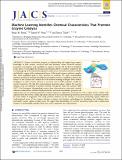Notice
This is not the latest version of this item. The latest version can be found at:https://dspace.mit.edu/handle/1721.1/135153.2
Machine Learning Identifies Chemical Characteristics That Promote Enzyme Catalysis
| dc.contributor.author | Bonk, Brian M | |
| dc.contributor.author | Weis, James W | |
| dc.contributor.author | Tidor, Bruce | |
| dc.date.accessioned | 2021-10-27T20:10:58Z | |
| dc.date.available | 2021-10-27T20:10:58Z | |
| dc.date.issued | 2019 | |
| dc.identifier.uri | https://hdl.handle.net/1721.1/135153 | |
| dc.description.abstract | Copyright © 2019 American Chemical Society. Despite tremendous progress in understanding and engineering enzymes, knowledge of how enzyme structures and their dynamics induce observed catalytic properties is incomplete, and capabilities to engineer enzymes fall far short of industrial needs. Here, we investigate the structural and dynamic drivers of enzyme catalysis for the rate-limiting step of the industrially important enzyme ketol-acid reductoisomerase (KARI) and identify a region of the conformational space of the bound enzyme-substrate complex that, when populated, leads to large increases in reactivity. We apply computational statistical mechanical methods that implement transition interface sampling to simulate the kinetics of the reaction and combine this with machine learning techniques from artificial intelligence to select features relevant to reactivity and to build predictive models for reactive trajectories. We find that conformational descriptors alone, without the need for dynamic ones, are sufficient to predict reactivity with greater than 85% accuracy (90% AUC). Key descriptors distinguishing reactive from almost-reactive trajectories quantify substrate conformation, substrate bond polarization, and metal coordination geometry and suggest their role in promoting substrate reactivity. Moreover, trajectories constrained to visit a region of the reactant well, separated from the rest by a simple hyperplane defined by ten conformational parameters, show increases in computed reactivity by many orders of magnitude. This study provides evidence for the existence of reactivity promoting regions within the conformational space of the enzyme-substrate complex and develops methodology for identifying and validating these particularly reactive regions of phase space. We suggest that identification of reactivity promoting regions and re-engineering enzymes to preferentially populate them may lead to significant rate enhancements. © | |
| dc.language.iso | en | |
| dc.publisher | American Chemical Society (ACS) | |
| dc.relation.isversionof | 10.1021/JACS.8B13879 | |
| dc.rights | Creative Commons Attribution-NonCommercial-NoDerivs License | |
| dc.rights.uri | http://creativecommons.org/licenses/by-nc-nd/4.0/ | |
| dc.source | ACS | |
| dc.title | Machine Learning Identifies Chemical Characteristics That Promote Enzyme Catalysis | |
| dc.type | Article | |
| dc.relation.journal | Journal of the American Chemical Society | |
| dc.eprint.version | Final published version | |
| dc.type.uri | http://purl.org/eprint/type/JournalArticle | |
| eprint.status | http://purl.org/eprint/status/PeerReviewed | |
| dc.date.updated | 2019-07-08T13:01:20Z | |
| dspace.orderedauthors | Bonk, BM; Weis, JW; Tidor, B | |
| dspace.date.submission | 2019-07-08T13:01:24Z | |
| mit.journal.volume | 141 | |
| mit.journal.issue | 9 | |
| mit.metadata.status | Authority Work and Publication Information Needed |
